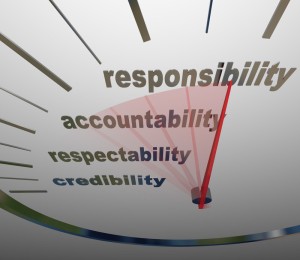
A good leader takes a little more than his share of the blame, a little less than his share of the credit. – Arnold H. Glasow
John Killinger tells a story about the manager of a minor leader baseball team who was so disgusted with his center fielder’s performance that he ordered him to the dugout and assumed the position himself.
The first ball that came into center field took a bad hop and hit the manager in the mouth. The next one was a high fly ball, which he lost in the glare of the sun and it bounced off his forehead. The third was a hard line drive that he charged with outstretched arms; unfortunately, it flew between his hands and smacked his eye. Furious, he ran back to the dugout, grabbed the center fielder by the uniform, and shouted, “You idiot! You’ve got center field so messed up that even I can’t do a thing with it!”
The coach in the story reminds us of the type of culture we live in. The blame game is easy to play and in the end, it serves no meaningful purpose. But as a leader, if you want to grow, move your organization forward, and create a culture of excellence it’s going to require a different mindset in order to pull it off. Here are my five rules of the blame game that can help you navigate your way forward.
Begin with yourself
In a “blame others first” culture this is where you are set apart as a leader. The tendency is to find someone to be the “fall guy” when things go south, but the leader steps up and takes responsibility. When you shoulder the responsibility as the leader you demonstrate that you are with and for your team not just in the good times but also when the chips are down. A good leader takes personal responsibility for his organization.
Look for solutions
Once responsibility has been taken it’s the time to move beyond whom to blame and work on solutions. This can be as simple as diagnosing a poor communication problem or perhaps something more complex. The point being; don’t dwell too long on who messed up but rather channel your energies on what to do next.
Attack bad attitudes
In order to coalesce team members around a new culture of excellence and move past a blame game mentality, you must address bad attitudes. “Your attitude, not your aptitude, will determine your altitude,” stated Zig Ziglar. Bad attitudes will ground your organization and will be the single greatest challenge to your leadership. The work of your team will be a reflection of their attitudes. Attack bad attitudes, keep yours positive and change your culture.
Manage mistakes wisely
The way you manage mistakes can pay great dividends but it all depends on how you handle it. Rather than demoralizing the offender with a wrong response why not use it the opportunity to do something constructive? As a leader, how you handle the mistakes of others speaks volumes about what’s most important to you. Those who blame belittle. Be a leader who encourages and turns the mistakes into something positive.
Examine motives
Understanding the blame game begins with identifying the motives for blaming others. Possibilities might include professional jealousy, subtle expressions of bullying, the deflection off of one’s own insecurities, etc. By examining the motives of those caught in playing the blame game card you can learn a lot about the inner workings of your organizational dynamics and patterns. As a leader, you need to have a handle on what is taking place in order to correct it.
Playing the blame game is too easy. Leading up is hard. Your leadership will rise when you rise up and do the right thing. If you want a better way forward then stop with the blame game.
© 2017 Doug Dickerson



 Liz Stincelli is the Founder of Stincelli Advisors where she focuses on helping organizations engage employees and improve organizational culture. She holds a Doctor of Management degree with an emphasis on organizational leadership. Learn more about Liz by visiting her website: www.stincelliadvisors.com
Liz Stincelli is the Founder of Stincelli Advisors where she focuses on helping organizations engage employees and improve organizational culture. She holds a Doctor of Management degree with an emphasis on organizational leadership. Learn more about Liz by visiting her website: www.stincelliadvisors.com




